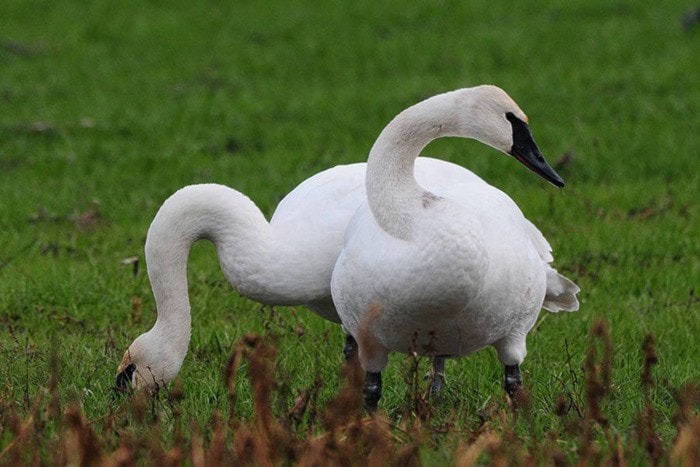The Comox Valley provides a winter sanctuary for one of wildlife's most elegant birds.
I have lived in the Valley for the past 20 years and still get a thrill when I hear the "honking" of the swans as they announce the end of another successful fall migration.
In one year these amazing swans make a return trip to the Arctic; they spend their summers in Alaska breeding and then raising their young before heading back to southern British Columbia where they will spend the winter preparing for the next spring migration, when the whole cycle will start again.
There are seven species of swans worldwide, the trumpeter swan being the largest. On average the adult swans weigh 12 kilograms with a huge 2.5-metre wingspan.
Adult swans have snowy white plumage with a distinct black beak that extends to the inner corners of their eyes, their feet and legs are black. In contrast the juvenile swans have light gray plumage for their first year, their beaks are pink and their legs and feet are a muddy yellow.
Sometimes the trumpeter swans are confused with the tundra swans that are similar but smaller and have very prominent yellow markings where the beak meets the inner corners of the eyes. Adult swans are monogamous and family oriented, the juveniles stay with the parents for the first year and make their first migration together.
Two weeks ago I heard and then saw a small flock of swans, the first arrivals of this season, flying over Merville to the potato fields they visit each winter. The severe winter storms we have experienced in the last few weeks may have delayed many of the swans as they often have to land until the storm has abated.
Leaving the Arctic area as soon as the first frosts arrive they have to start their migration whilst there is still open water. Being such large birds they need a water "runway" to take off, they will run along on top of the water until they can become airborne.
The southern migration is particularly gruelling for the family, especially the young, they need to be in top flying condition and carry sufficient fat supplies to last them until they can make a stop to refuel.
Sadly many first year swans do not survive the rigours of the migration and perish en route, others arrive weak and starving these are usually the swans that arrive for care at our centre.
Trumpeter swans have a mixed diet depending on the season, in the spring their arrival coincides with the explosion of thousands of insects which they consume together with newly emerging aquatic vegetation.
In the winter their diet consists of natural aquatic vegetation and insects found in the estuaries together with roots, especially potatoes, and grasses that are provided for them by the trumpeter swan management program, thanks to the local farmers and their flooded fields.
As the swans return to their winter feeding grounds they gather in large social flocks in the fields, most of the daylight hours are spent in the estuaries or shallow shore lines at night they seek the safety of the inland fields.
Flocks of swans can been seen in various parts of the Comox Valley one of the most visible areas is the Comox Valley Farm fields between the Fifth and 17th Street bridges.
Please do not stop in this area because the swans can panic and attempt flight before they are fully prepared.
Due to their size swans are prone to electrocution; often they have to deal with fog or high winds both of which can interfere with their ability to avoid power lines.
Trumpeter swans are also susceptible to toxins which may have leached into the muddy waters. This can cause neurological damage to the swans and this can be seen by the swan spinning and falling over.
Each year a group of naturalists and volunteers monitor the swans with a weekly count throughout the Comox Valley. The data collected is critical to the future well being of the swans and their habitat.
In celebration of these magnificent birds, MARS will hold a Swan Fest on Saturday, Nov. 23 at the K'omox First Nations Hall on the Dyke Road. Come out and learn more about the swans and enter our photo contest and meet the MARS ambassador birds.
Please go to www.wingtips.org for more details. To report injured or orphaned wildlife, please call 250-337-2021.
Sandy Fairfield is the educational co-ordinator for the Mountainaire Avian Rescue Society (MARS). The MARS column appears every second Thursday.
